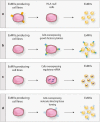Horizontal transfer of RNA and proteins between cells by extracellular microvesicles: 14 years later
- PMID: 26943717
- PMCID: PMC4779088
- DOI: 10.1186/s40169-016-0087-4
Horizontal transfer of RNA and proteins between cells by extracellular microvesicles: 14 years later
Abstract
Extracellular microvesicles (ExMVs) are part of the cell secretome, and evidence has accumulated for their involvement in several biological processes. Fourteen years ago our team demonstrated for the first time that ExMVs carry functional RNA species and proteins from one cell to another, an observation that opened up the new research field of horizontal transfer of bioactive molecules in cell-to-cell communication. Moreover, the presence of mRNA, noncoding RNA, and miRNA in ExMVs in blood and other biological fluids opened up the possibility of employing ExMVs as new detection markers for pathological processes, and ExMVs became a target for "liquid biopsy" approaches. While ExMV-derived mRNAs may be translated in target cells into appropriate proteins, miRNAs regulate expression of corresponding mRNA species, and both RNA-depended ExMV-mediated mechanisms lead to functional changes in the target cells. Following from this observation, several excellent papers have been published that confirm the existence of the horizontal transfer of RNA. Moreover, in addition to RNA, proteins, bioactive lipids, infectious particles and intact organelles such as mitochondria may follow a similar mechanism. In this review we will summarize the impressive progress in this field-14 years after initial report.
Keywords: Circulating RNA; ExMVs; Exosomes; Horizontal transfer of RNA; Liquid biopsies; RNA; Regenerative medicine.
Figures


References
-
- Lener T, Gimona M, Aigner L, Börger V, Buzas E, Camussi G, Chaput N, Chatterjee D, Court FA, Del Portillo HA, O’Driscoll L, Fais S, Falcon-Perez JM, Felderhoff-Mueser U, Fraile L, Gho YS, Görgens A, Gupta RC, Hendrix A, Hermann DM, Hill AF, Hochberg F, Horn PA, de Kleijn D, Kordelas L, Kramer BW, Krämer-Albers EM, Laner-Plamberger S, Laitinen S, Leonardi T, Lorenowicz MJ, Lim SK, Lötvall J, Maguire CA, Marcilla A, Nazarenko I, Ochiya T, Patel T, Pedersen S, Pocsfalvi G, Pluchino S, Quesenberry P, Reischl IG, Rivera FJ, Sanzenbacher R, Schallmoser K, Slaper-Cortenbach I, Strunk D, Tonn T, Vader P, van Balkom BW, Wauben M, Andaloussi SE, Théry C, Rohde E, Giebel B. Applying extracellular vesicles based therapeutics in clinical trials—an ISEV position paper. J Extracell Vesicles. 2015;31(4):30087. - PMC - PubMed
-
- Collino F, Deregibus MC, Bruno S, Sterpone L, Aghemo G, Viltono L, Tetta C, Camussi G. Microvesicles derived from adult human bone marrow and tissue specific mesenchymal stem cells shuttle selected pattern of miRNAs. PLoS One. 2010;5(7):e11803. doi: 10.1371/journal.pone.0011803. - DOI - PMC - PubMed
Grants and funding
LinkOut - more resources
Full Text Sources
Other Literature Sources
